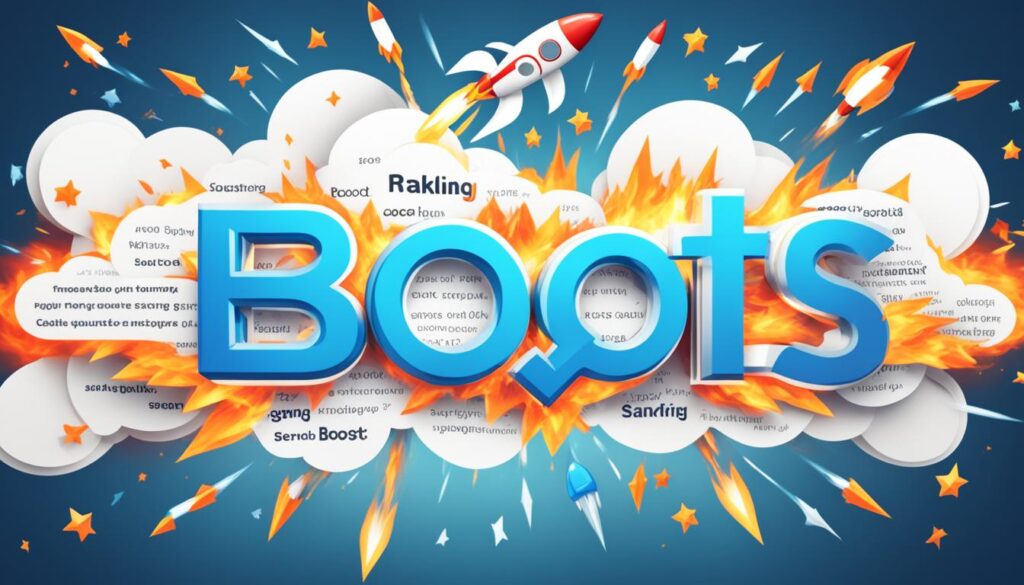Have you ever wondered how some websites consistently appear at the top of search engine results? Is there a secret formula that allows them to effortlessly boost their search engine rankings while others struggle to gain visibility?
Search engine ranking is crucial for improving online visibility and driving organic traffic to your website. It’s not just about being on the first page of search results; it’s about being among the top search results that capture the attention of users. But how can you improve your search engine ranking without spending a fortune on paid ads or hiring an army of experts?
In this article, we will guide you through the steps to improve your search engine ranking effortlessly. We will explore proven SEO techniques, optimization strategies, and insider tips to help you boost your website ranking and achieve high search engine rankings consistently.
Key Takeaways:
- Improving search engine ranking is crucial for online visibility and organic traffic.
- Effective SEO techniques and website optimization can lead to higher search engine rankings.
- This article will provide a step-by-step guide to effortlessly boost your search engine ranking.
- Learn how to implement proven strategies and optimize your website for top search results.
- Unlock the secrets to improving your search engine ranking and stand out from the competition.
Understanding Google Ranking Metrics
When it comes to search engine ranking, Google’s ranking metrics are the key players. These metrics, influenced by Google’s algorithmic process, determine the position of a webpage in search engine results. To improve your search engine ranking, it is crucial to understand these metrics and their impact on your website’s visibility.
Google’s algorithmic process evaluates various factors to determine the quality, relevancy, and utility of a webpage in response to a search query. This complex process analyzes the content, structure, and user experience of a webpage to deliver the most relevant results.
Google’s ranking metrics focus on ensuring that search results are of high quality and relevant to the user’s search query. By understanding these metrics, website owners and SEO professionals can optimize their webpages to meet Google’s standards and improve their search engine rankings.
Quality and Relevancy
Quality and relevancy are the cornerstones of Google’s ranking metrics. To rank higher in search results, your webpage must offer valuable and authoritative content that meets the needs of your target audience.
Google’s algorithm evaluates the quality of your content based on factors such as originality, accuracy, and comprehensiveness. It considers the expertise of the author, the trustworthiness of the website, and the overall user experience. By creating high-quality content that provides value to users, you can improve your search engine ranking.
Relevancy is another crucial aspect of Google’s ranking metrics. Your webpage should align with the user’s search intent and provide the most relevant information. Understanding the search query and optimizing your content accordingly can make a significant difference in your search engine ranking.
The Importance of Search Query
The search query plays a vital role in determining how Google ranks webpages. It’s essential to analyze the intent behind the search query and optimize your content to match it.
Google aims to provide the most accurate and relevant results based on the user’s search query. By analyzing the search query and understanding the user’s intent, you can create content that addresses their needs and aligns with their expectations.
Optimizing your content for the search query involves using relevant keywords, providing useful information, and structuring your content in a way that makes it easy for search engines to understand. By focusing on the search query, you can improve your search engine ranking and attract more organic traffic to your website.
Understanding Google Ranking Metrics is Essential for SEO Success
Improving your search engine ranking requires a deep understanding of Google’s ranking metrics and how they impact your website’s visibility. By optimizing your content for quality, relevancy, and the user’s search intent, you can enhance your chances of ranking higher in search results.
Step-by-Step Guide to Improve On-Site SEO
When it comes to improving search engine rankings, on-site SEO plays a crucial role. By optimizing your webpage’s structure, content, and keywords, you can effectively communicate to search engines that your page is relevant to specific search queries. In this section, we will provide you with a step-by-step guide on how to improve your on-site SEO for better search engine rankings.
1. Conduct Keyword Research: Start by identifying relevant keywords that are frequently searched by your target audience. Use keyword research tools to gather a list of high-potential keywords for your website.
2. Optimize Meta Tags: Ensure that your title tags and meta descriptions contain the target keywords. Write compelling, concise, and keyword-rich meta tags that entice users to click through to your website.
3. Improve Content Length: Create high-quality, in-depth content that provides value to your audience. Long-form content tends to perform better in search engine rankings, so aim for a content length of at least 1,000 words or more.
4. Enhance Keyword Placement: Strategically place your target keywords in key areas of your webpage, such as the page title, headings, subheadings, and within the body of the content. However, ensure that your keyword placement feels natural and does not compromise the readability of your content.
5. Optimize URL Structure: Create clean and descriptive URLs that include relevant keywords. Avoid using long and confusing URLs that may confuse both search engines and users.
6. Use Header Tags: Utilize header tags (h1, h2, h3, etc.) to structure your content. Include your target keywords within these header tags to signal the relevance of the content to search engines.
7. Incorporate LSI Keywords: Enhance the relevance and context of your content by including LSI (Latent Semantic Indexing) keywords. LSI keywords are closely related terms that provide additional context and improve the overall optimization of your content.

8. Optimize Internal Linking: Create a strong internal linking structure that connects relevant pages within your website. Use keyword-rich anchor text to signal the relevance of the linked pages and distribute authority throughout your website.
9. Improve Website Load Speed: Increase your website’s load speed by optimizing image sizes, minifying code, and utilizing caching mechanisms. A faster website provides a better user experience and can positively impact your search engine rankings.
10. Ensure Mobile Responsiveness: With the majority of internet users browsing on mobile devices, it’s crucial to have a mobile-responsive website. Optimize your website design and content layout to provide a seamless user experience on all devices.
11. Implement Schema Markup: Add structured data using schema markup to provide search engines with additional information about your website’s content. Schema markup enhances the visibility of your web pages in search engine results pages (SERPs).
12. Regularly Update and Improve: Continuously monitor and update your website’s content to keep it fresh and relevant. Regularly adding new content and improving existing content demonstrates to search engines that your website is active and valuable.
By following this step-by-step guide, you can optimize your on-site SEO and improve your search engine rankings. Implement these techniques consistently, and monitor your website’s performance to ensure continuous improvement and success.
Harnessing the Power of LSI Keywords
LSI (Latent Semantic Indexing) keywords are an invaluable tool in optimizing your content for search engine rankings. These related words and phrases enhance the relevance and overall contextual understanding of your webpage. By strategically incorporating LSI keywords throughout your content, you can further optimize your website for improved search engine visibility and higher rankings.
Discover how to effectively find and use LSI keywords to maximize the impact of your SEO efforts:
1. Comprehensive Keyword Research
Begin by conducting comprehensive keyword research to identify both primary and LSI keywords relevant to your content. Utilize keyword research tools to explore related keywords and phrases that align with your target audience’s search intent.
2. Analyze Search Results
Analyze the search results for your primary keyword to identify LSI keywords commonly associated with top-ranking webpages. Examine the content and structure of these pages to gain insights into the keywords they utilize.
3. Natural Integration
Integrate LSI keywords in a way that feels organic and natural. Avoid overstuffing your content with keywords, as this can negatively impact user experience and search engine rankings. Instead, focus on creating high-quality, informative content that naturally incorporates LSI keywords.
4. Enhance Content Relevance
By including LSI keywords that are semantically related to your primary keyword, you can enhance the content’s relevance and promote a more comprehensive understanding of your webpage. This improves its chances of ranking higher in search engine results.
5. Optimize for Search Intent
Consider the search intent behind the keywords you’re targeting and optimize your content accordingly. Ensuring that your content aligns with searcher intent increases the likelihood of your webpage appearing prominently in search results.
“By strategically incorporating LSI keywords throughout your content, you can further optimize your website for improved search engine visibility and higher rankings.”
Implementing LSI keywords effectively can significantly strengthen your SEO strategy and improve your search engine rankings. By accurately understanding the context of your content and aligning it with search intent, you can create a more authoritative and impactful online presence.

| Benefits of LSI Keywords | Examples |
|---|---|
| Enhanced relevance | “Chocolate” – LSI keyword: “cocoa”, “truffles” |
| Contextual understanding | “Fitness tips” – LSI keyword: “exercise routines”, “healthy diet” |
| Improved search engine rankings | “Digital marketing” – LSI keyword: “SEO strategies”, “content marketing” |
| Expanded content optimization | “Travel destinations” – LSI keyword: “tourist attractions”, “beach resorts” |
Monitoring and Optimizing Technical SEO
Technical SEO is a critical aspect of improving your search engine rankings. While often overlooked, optimizing technical elements such as mobile optimization, page speed, and addressing indexing issues can have a significant impact on the visibility and performance of your website.
One crucial aspect of technical SEO is mobile optimization. With the increasing number of users accessing the internet via mobile devices, search engines prioritize websites that provide a seamless mobile experience. Optimizing your website for mobile devices ensures that it loads quickly, is easy to navigate, and provides a user-friendly experience across all screen sizes. This not only enhances user satisfaction but also improves your search engine rankings.
Another essential factor in technical SEO is the page speed. Users expect websites to load quickly, and search engines take this into account when ranking webpages. Slow-loading pages not only contribute to a poor user experience but also negatively impact your search engine rankings. By optimizing your website’s code, compressing images, and leveraging caching techniques, you can significantly improve your page speed and overall performance.
Moreover, technical SEO involves addressing indexing issues. Ensuring that search engines can easily crawl and index your website’s pages is crucial for visibility. If certain pages are not indexed, they won’t appear in search results, which limits your organic reach. By conducting regular audits, fixing broken links, improving site architecture, and submitting an XML sitemap, you can eliminate indexing issues and ensure that search engines can fully understand and catalog your website.
Key Considerations for Monitoring and Optimizing Technical SEO:
- Regularly monitor your website’s mobile-friendliness using tools like Google’s Mobile-Friendly Test. Make the necessary changes to optimize the mobile experience.
- Measure your website’s page speed performance using tools like Google PageSpeed Insights or GTmetrix. Optimize your website by following the recommendations provided.
- Use tools like Google Search Console to identify indexing issues and fix any crawl errors or indexation problems.
- Consider implementing structured data markup to enhance your website’s visibility in search results and enable rich snippets.
- Regularly monitor your website’s performance metrics, including organic traffic, bounce rate, and average session duration, to identify areas for improvement.
By consistently monitoring and optimizing these technical aspects, you can enhance your website’s visibility, improve user experience, and boost your search engine rankings.

Creating Content Aligned with Search Intent
When it comes to improving your search engine rankings, it’s essential to understand search intent and align your content with it. Search intent refers to the underlying purpose or motivation behind a user’s search query. By creating content that meets the search intent of your target audience, you can enhance the user experience and increase their satisfaction with your website.
When a user enters a search query, they have a specific goal in mind. It could be informational, navigational, transactional, or even a combination of these. Your content should cater to their specific intent, addressing their needs and providing valuable information. This helps you not only attract more organic traffic but also retain users on your website.
One way to create content aligned with search intent is to conduct thorough keyword research. Identify the keywords that users are using to search for information related to your industry or niche. Then, analyze the search intent behind these keywords. Are users looking for more detailed information, product comparisons, or solutions to their problems?
For example:
If you have a website selling running shoes, a user searching for “best running shoes for marathon” has an informational search intent. They are looking for recommendations and advice on choosing the right running shoes for marathon races. In this case, your content should provide comprehensive reviews, expert tips, and detailed comparisons of different running shoe models.
By understanding the search intent, you can tailor your content to provide the most relevant and valuable information to users. This not only helps improve your search engine rankings but also enhances the overall user experience on your website.
Additionally, optimizing your content to align with search intent can also help improve other ranking factors such as bounce rate and time spent on page. When users find your content highly relevant and informative, they are more likely to engage with it, explore other pages on your website, and share it with others. This, in turn, signals to search engines that your content is valuable and satisfies user intent, leading to improved rankings.

When creating content aligned with search intent, consider the following strategies:
- Carry out comprehensive keyword research to identify search intent and related keywords.
- Create high-quality, informative content that addresses the specific needs and questions of your target audience.
- Provide multiple forms of content (text, images, videos) to cater to different user preferences.
- Include relevant headings, subheadings, and bullet points to make your content scannable and easy to navigate.
- Use internal links to guide users to related content on your website.
Remember: Your goal is to provide the best possible user experience by delivering content that aligns with search intent. By doing so, you can improve your search engine rankings, increase organic traffic, and ultimately satisfy your users’ needs.
| Benefits of Creating Content Aligned with Search Intent | Ranking Impact | User Experience | User Satisfaction |
|---|---|---|---|
| Higher search engine rankings | Improved | Enhanced | Increased |
| More organic traffic | Positive | Optimized | Satisfied |
| Better engagement metrics | Significant | Improved | Enhanced |
| Increased conversions | Boosted | Positive | Optimized |
Reducing Bounce Rate for Better Rankings
A high bounce rate can have a negative impact on your search engine rankings. When visitors quickly leave your website without engaging with your content, search engines interpret it as a sign of poor user experience or irrelevant content, leading to lower rankings in search results. To improve your search engine rankings and retain users on your website, it is crucial to focus on reducing the bounce rate.
Engaging and relevant content plays a vital role in keeping visitors on your website. By creating content that meets the expectations of your target audience and aligns with their search intent, you can significantly reduce bounce rate and increase user engagement. When visitors find valuable and informative content on your website, they are more likely to stay, explore further, and interact with your website, sending positive signals to search engines and improving your rankings.
Additionally, optimizing the usability of your website can contribute to a lower bounce rate. Ensuring easy navigation, clear call-to-action buttons, intuitive user interface, and fast-loading pages enhance user experience and encourage visitors to stay longer on your website. A user-friendly website that provides a seamless browsing experience will not only reduce bounce rate but also have a positive impact on your search engine rankings.
“Creating engaging and relevant content that meets the expectations of your visitors can lead to a significant improvement in your search engine rankings.”
By prioritizing content relevance and usability, you can effectively reduce bounce rate and improve your search engine rankings. However, it is essential to regularly monitor your website’s performance and analyze user behavior to identify areas for improvement. Use analytics tools to track bounce rate, time spent on page, and other engagement metrics to gain insights into user preferences and optimize your website accordingly.
Strategies to Lower Bounce Rate:
- Create compelling headlines to capture visitors’ attention and entice them to explore further.
- Deliver valuable and informative content that meets the search intent of your target audience.
- Optimize website usability for easy navigation, intuitive interface, and fast loading times.
- Improve website design and user experience to encourage engagement and interaction.
- Include clear call-to-action buttons to guide visitors to take desired actions.
- Enhance page loading speed to prevent visitors from leaving due to slow performance.
Implementing these strategies can help you lower your bounce rate, improve user engagement, and ultimately boost your search engine rankings.
Now that you understand the importance of reducing bounce rate for better rankings, let’s explore other SEO techniques and strategies to optimize your website and improve your search engine visibility.

Optimize Internal Linking for Better Rankings
Internal linking is a powerful SEO strategy that can greatly improve your search engine rankings. By strategically linking relevant pages within your website, you can enhance your website structure, distribute page authority, and enhance user navigation. Let’s delve into the key components of optimizing internal linking for better rankings.
1. Anchor Text
Anchor text refers to the clickable text within a hyperlink. It is crucial to use descriptive and relevant anchor text when linking internally. By incorporating target keywords and providing context in your anchor text, you can enhance the search engine’s understanding of the linked page’s content. For example:
Learn more about on-site SEO techniques
2. Website Structure
An effective website structure is essential for both search engines and visitors. Organize your website into categories and subcategories, creating a logical hierarchy. This allows search engines to crawl and index your pages more efficiently, improving your search engine rankings. Consider the following website structure:
| Category | Subcategory | Page |
|---|---|---|
| On-Site SEO | Keyword Optimization | The importance of keyword optimization |
| On-Site SEO | Content Length | How content length affects SEO |
3. Page Authority Distribution
Internal linking can distribute page authority throughout your website, strengthening the visibility and ranking potential of individual pages. By linking from high-authority pages to others that require a boost in rankings, you can elevate the visibility and ranking of those pages. Consider the following example:
The high-authority page shares internal links with other pages, passing on its authority and improving their rankings.
4. User Navigation
Optimizing internal linking also improves user navigation, ensuring visitors can easily find relevant content. By providing contextual links within your content, you can guide users to related information, enhancing their experience on your website. This boosts user satisfaction and can indirectly impact your search engine rankings.
Optimizing internal linking is a crucial aspect of improving your search engine rankings. By using descriptive anchor text, establishing a clear website structure, distributing page authority strategically, and enhancing user navigation, you can effectively optimize your internal linking. Implement these strategies to boost your rankings and provide a seamless browsing experience for your users.
Enhancing User Experience with Meaningful Visuals
When it comes to improving search engine rankings and engaging users, the power of visual elements should not be underestimated. Meaningful visuals can captivate your audience, convey information effectively, and enhance the overall user experience on your website.
One key aspect of visual optimization is the proper use of alt tags. Alt tags are descriptive text alternatives that provide information about an image for users who are visually impaired or unable to load images. By including relevant keywords in your alt tags, you can improve the accessibility of your website while also signaling to search engines the content and context of your images.
Another crucial factor for visual optimization is ensuring responsive design for mobile devices. With the increasing number of users accessing the internet through their smartphones and tablets, it is essential to create a seamless and visually appealing experience across all devices. Responsive design allows your website to adapt to different screen sizes and resolutions, providing optimal user engagement and retention.
Benefits of Meaningful Visuals:
- Enhanced user engagement: Meaningful visuals capture users’ attention, encourage them to stay longer on your website, and interact with your content.
- Improved comprehension: Visuals can simplify complex information, making it easier for users to understand your message.
- Increased shareability: Compelling visuals are more likely to be shared on social media platforms, expanding your reach and driving organic traffic to your site.
- Optimized user experience: Well-placed visuals break up the text, making it easier to read and navigate, resulting in a better overall user experience.
We believe that incorporating meaningful visuals into your website is an effective way to engage users, improve search engine rankings, and enhance the overall user experience. By optimizing image attributes, such as alt tags, and ensuring responsive design, you can create a visually appealing website that captivates your audience and ranks higher in search engine results.
Implementing Advanced SEO Techniques for Ranking Boost
To achieve higher search engine rankings, it’s essential to implement advanced SEO techniques that go beyond basic optimization. In this section, we will explore strategies that can give your website a significant ranking boost.
Utilizing Rich Snippets for Enhanced Search Visibility
Rich snippets are additional data displayed in search engine results that provide users with a preview of what they can expect from your webpage. By incorporating structured data markup into your web pages, you can enhance search visibility and attract more qualified traffic. Implementing rich snippets helps search engines understand your content better and display relevant information to users. For example, you can use schema markup to highlight product reviews, ratings, pricing, event details, and much more.
Implementing Structured Data with Schema Markup
Structured data provides a standardized format for organizing and categorizing information on your website. By implementing schema markup, you can create a common language that helps search engines understand the context and purpose of your content. By providing search engines with detailed information about your business, products, events, and other entities, you increase the chances of appearing in rich search results and attracting more targeted traffic. Schema markup can improve both the appearance and relevancy of your search engine listings.
Optimizing for Voice Search
Voice search is rapidly growing in popularity, and optimizing your website for this trend can help you gain a competitive advantage. Voice search optimization involves tailoring your content to match the natural language patterns that people use when speaking their queries out loud. By creating conversational content and incorporating long-tail keywords, you can increase the chances of your website appearing in voice search results. Voice search optimization also involves ensuring that your website loads quickly and is mobile-friendly, as mobile devices are frequently used for voice searches.
By implementing these advanced SEO techniques, including utilizing rich snippets, implementing structured data with schema markup, and optimizing for voice search, you can boost your website’s search engine rankings and increase your online visibility. The key is to stay updated with the latest trends in SEO and adapt your strategies accordingly to stay ahead of the competition.
| Advanced SEO Techniques | Benefits |
|---|---|
| Utilizing rich snippets | Enhanced search visibility, increased click-through rates |
| Implementing structured data | Better understanding of your content by search engines, increased chances of appearing in rich search results |
| Optimizing for voice search | Gaining a competitive advantage, tapping into the growing popularity of voice search |
Tracking and Analyzing Results for Continuous Improvement
Measuring the effectiveness of your SEO strategies is essential for continuous improvement and achieving better search engine rankings. By tracking and analyzing your SEO results, you can make data-driven decisions and identify areas that require optimization. To do this, utilize powerful analytics tools that provide valuable insights into your website’s performance.
Monitor Organic Traffic
One of the primary key metrics to track is organic traffic – the number of visitors who find your website through search engine results. By monitoring organic traffic trends, you can determine whether your SEO efforts are attracting more visitors to your site. Analytics tools like Google Analytics help you visualize the flow of organic traffic, allowing you to analyze patterns and identify any fluctuations or trends.
Analyze Keyword Rankings
Keyword rankings are a crucial component of search engine optimization. Tracking the performance of your target keywords provides insights into how well your website is ranking in search engine results pages (SERPs). Utilize keyword ranking tools to monitor your keyword positions over time, identifying both improvements and potential areas for optimization.
Utilize Analytics Tools
Analytics tools are essential for tracking and analyzing SEO results effectively. Google Analytics is a widely used tool that provides comprehensive reports on website performance, including information on traffic sources, keyword rankings, user behavior, and more. Other analytics tools like SEMrush and Moz offer additional features and insights to enhance your SEO analysis.
| Analytics Tool | Key Features |
|---|---|
| Google Analytics | Comprehensive website performance reports, traffic sources analysis, keyword rankings, user behavior data |
| SEMrush | Competitive analysis, keyword research, backlink analysis, site audit, rank tracking |
| Moz | Website crawling, keyword research, rank tracking, on-page optimization, link analysis |
Identify Areas for Improvement
By tracking SEO results and analyzing the data, you can identify areas for improvement and optimization. For example, if you notice a decline in organic traffic for specific keywords, it may indicate the need for content optimization or backlink building. Use the insights gained from tracking SEO results to develop actionable strategies for continuous improvement.
“Tracking and analyzing SEO results is a continuous process. By utilizing analytics tools, we can gain valuable insights that help us optimize our strategies and achieve better search engine rankings.”
In conclusion, tracking and analyzing SEO results is crucial for continuous improvement and achieving better search engine rankings. By monitoring organic traffic, analyzing keyword rankings, utilizing analytics tools, and identifying areas for improvement, you can optimize your SEO strategies and enhance your website’s visibility in search engine results.
Conclusion and Next Steps
Improving your search engine ranking requires continuous optimization and the implementation of effective SEO strategies. By following the steps outlined in this article and staying up to date with the latest SEO trends, you can enhance the visibility of your website, attract more organic traffic, and consistently rank higher in search engine results.
To improve your search engine ranking, it is essential to focus on on-site SEO by optimizing your website’s structure, content, and keywords. Additionally, incorporate LSI keywords to enhance content relevance and utilize technical SEO techniques like mobile optimization, page speed optimization, and addressing indexing issues.
Aligning your content with user search intent is another crucial aspect of improving your search engine ranking. By creating engaging and informative content that meets the expectations of your target audience, you can increase user satisfaction and drive better rankings. Reduce your bounce rate by providing relevant content and optimizing your internal linking strategy to improve user engagement and website navigation.
Lastly, enhance user experience with meaningful visuals, such as images and videos, and optimize them using alt tags. Implement advanced SEO techniques like structured data with schema markup and voice search optimization to give your website an edge. By continuously tracking and analyzing your SEO efforts using analytics tools, you can identify opportunities for improvement and optimize your search engine ranking over time.






